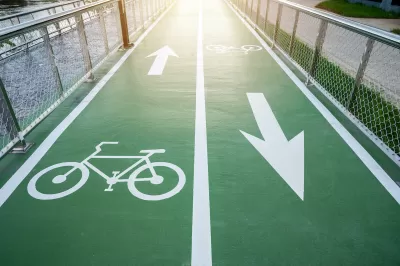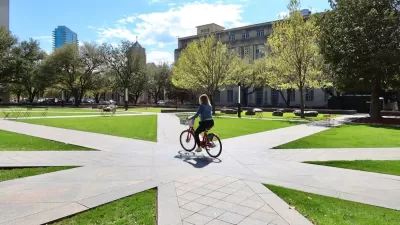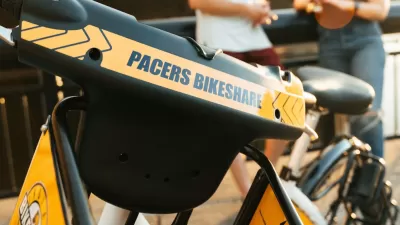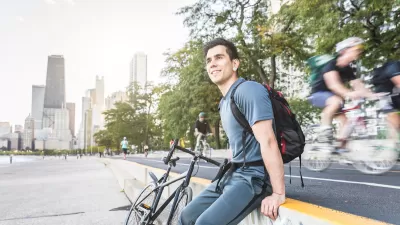Getting more people on bikes requires safe, comfortable bike infrastructure and connectivity to transit.

May is National Bike Month, and cycling advocates around the country are both celebrating recent victories and calling attention to the work that remains to make U.S. bike infrastructure safe and comprehensive. While some cities have made significant strides in building out their protected bike lane networks and making it easier to connect biking with other transit options, others continue to lag behind. Despite a plethora of Vision Zero pledges, cyclist and pedestrian deaths remain at all-time highs in many parts of the country.
Which cities rate highest for bike infrastructure? Where do bike commuters use facilities the most? Where can you get a government subsidy for buying an e-bike? Find out below!
U.S. cities with highest 2023 PeopleForBikes bike scores:
- Provincetown, Massachusetts
- Crested Butte, Colorado
- Blue Diamond, Nevada
- Murdock, Nebraska
- Ashland, Wisconsin
- Jackson, Wyoming
- Davis, California
- Aspen, Colorado
- Shorewood, Wisconsin
- Ankeny, Iowa
Large U.S. cities with highest 2023 PeopleForBikes bike scores:
- Minneapolis, Minnesota
- San Francisco, California
- Seattle, Washington
- Philadelphia, Pennsylvania
- Portland, Oregon
- New York City, New York
- St. Paul, Minnesota
- Washington, D.C.
- Milwaukee, Wisconsin
- Detroit, Michigan
U.S. cities with the highest percentage of bike commuters*
- Portland, Oregon: 6.3%
- Washington, D.C.: 5%
- Minneapolis, Minnesota: 3.9%
- San Francisco, California: 3.1%
- New Orleans, Louisiana: 2.9%
- Seattle, Washington: 2.8%
- Philadelphia, Pennsylvania: 2.6%
- Tucson, Arizona: 2.5%
- Oakland, California: 2.3%
- Denver, Colorado: 2.2%
*This list is based on 2019 data, but conditions in some cities have changed since then.
U.S. cities with e-bike subsidies*
- Alameda County, California
- Berkeley, California
- Contra Costa County, California
- Healdsburg, California
- Los Angeles County, California
- Monterey County, California
- Orange County, California
- Pasadena, California
- Redding, California
- Riverside County, California
- San Bernardino County, California
- San Francisco, California
- Santa Barbara, California
- Santa Clara, California
- Santa Cruz, California
- Boulder, Colorado
- Denver, Colorado
- Atlanta, Georgia
- Bloomington, Indiana (on hold)
- Raleigh, North Carolina
- Columbus, Ohio
- Ashland, Oregon
- Eugene, Oregon
- Austin, Texas
- Washington, D.C.
Additionally, Colorado, Connecticut, Hawaii, Rhode Island, and Vermont offer statewide incentives, and bills supporting e-bike rebates are making their way through more state legislatures.
*Some smaller incentive programs exist that may not be included in this list.

Americans May Be Stuck — But Why?
Americans are moving a lot less than they once did, and that is a problem. While Yoni Applebaum, in his highly-publicized article Stuck, gets the reasons badly wrong, it's still important to ask: why are we moving so much less than before?

Using Old Oil and Gas Wells for Green Energy Storage
Penn State researchers have found that repurposing abandoned oil and gas wells for geothermal-assisted compressed-air energy storage can boost efficiency, reduce environmental risks, and support clean energy and job transitions.

Placekeeping: Setting a New Precedent for City Planners
How a preservation-based approach to redevelopment and urban design can prevent displacement and honor legacy communities.

Idaho Data: Unexpected Vehicle Repairs Exacerbate Housing Instability, Eviction Risk
Over 21 percent of clients struggle with transportation barriers.

A Year-Long Investigation On Permanent Supportive Housing
The New York Times reveals what’s working and what’s not in the cornerstone of Housing First.

Survey: US Public Spaces Not Meeting Community Needs
A lack of funding prevents many U.S. parks and public spaces from playing a more significant role in helping residents meet daily needs.
Urban Design for Planners 1: Software Tools
This six-course series explores essential urban design concepts using open source software and equips planners with the tools they need to participate fully in the urban design process.
Planning for Universal Design
Learn the tools for implementing Universal Design in planning regulations.
Heyer Gruel & Associates PA
City of Moreno Valley
Institute for Housing and Urban Development Studies (IHS)
City of Grandview
Harvard GSD Executive Education
Salt Lake City
NYU Wagner Graduate School of Public Service
City of Cambridge, Maryland






























